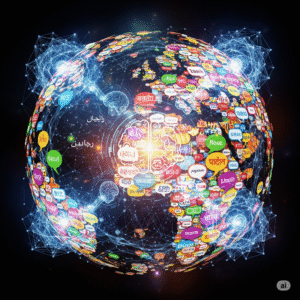We’ve all heard the stories. A scientist has a dream and discovers the structure of benzene. An engineer sees a burr stuck to their dog’s fur and invents Velcro. These eureka moments feel like magic—rare flashes of human genius that connect disparate concepts to solve a problem. But what if we could systematize that magic? What if we had a partner capable of drawing connections from millions of data points, far beyond human capacity, to generate truly groundbreaking ideas? This isn’t science fiction anymore. It’s the new frontier of innovation, powered by AI novel solutions.
For years, we’ve viewed AI as a tool for optimization and automation—making existing processes faster and more efficient. That’s incredibly valuable, but it’s only half the story. The real paradigm shift is happening now, as we begin to use AI not just to analyze the past, but to invent the future. We’re moving from AI as an analyst to AI as an inventor. This powerful idea generation AI is breaking down barriers in science, engineering, and business by proposing solutions that humans may have never conceived on their own. This guide will explore how this technology works, showcase real-world breakthroughs, and provide a practical roadmap for you to start generating AI novel solutions to your own “impossible” problems.
What Are AI Novel Solutions, and Why Do They Matter?
First, let’s define our terms. An AI novel solution is not just a data-driven recommendation or a slight improvement on an existing idea. It’s a genuinely new concept, design, or approach generated by an AI system that addresses a problem in a way that is non-obvious and potentially transformative. It’s the difference between an AI that suggests the most popular color for a new car (optimization) and an AI that proposes a completely new, self-healing material for the car’s body (invention).
This matters because human innovation, for all its brilliance, is limited by our own cognitive biases and the scope of our knowledge. We tend to think linearly and draw from our own experiences. An AI, on the other hand, can be trained on the entire corpus of scientific papers, patent databases, and material science data. It can then identify hidden patterns and forge unconventional connections at a scale no human brain can match. This ability to go beyond known patterns is the key to unlocking true breakthroughs and tackling some of the world’s most complex challenges.
Moving Beyond Patterns with AI Novel Solutions
The magic of AI novel solutions lies in a concept called “generative” AI. Unlike older AI models that were purely analytical, generative models can create new content—be it text, images, or even molecular structures. They learn the underlying rules and relationships within a dataset and then use that understanding to produce entirely new outputs that still adhere to those rules. Think of it like a musician who masters music theory (the rules) and then uses it to compose a completely original symphony, not just a remix of existing songs. This is precisely how AI is beginning to compose novel solutions in fields like medicine and engineering.
How Idea Generation AI Sparks Unthinkable Breakthroughs
The core of this revolution is idea generation AI. These systems are designed to mimic and augment human creativity. For instance, they can use analogical reasoning to solve problems. A human might look at a bird’s wing to design a better airplane. An AI can scan thousands of biological systems, patents, and physical phenomena to find much more obscure but effective analogies to solve an engineering challenge. This combinatorial creativity—mixing and matching concepts from vast and unrelated domains—is where AI truly shines.
It’s not about replacing human ingenuity but about providing a powerful new tool for exploration. An AI novel solutions platform can generate a thousand diverse starting points, allowing human experts to use their intuition and experience to identify the most promising avenues. This collaboration compresses years of research and development into weeks or months, drastically accelerating the pace of innovation. As detailed in a McKinsey report on AI’s impact, this synergy is creating immense value across the global economy.
Case Study: DeepMind’s AlphaFold and Protein Folding
One of the most powerful real-world examples of AI novel solutions is DeepMind’s AlphaFold. For 50 years, scientists struggled with the “protein folding problem”—predicting the 3D structure of a protein from its amino acid sequence. This is a grand challenge in biology because a protein’s shape determines its function. Solving it could unlock cures for diseases like Alzheimer’s and Parkinson’s.
Human scientists had made slow progress for decades. Then came AlphaFold. By training on a database of known protein structures, the AI learned the complex physical rules governing how they fold. It then began predicting the structures of unknown proteins with astounding accuracy. It didn’t just find patterns; it built a deep, intuitive understanding of the problem. AlphaFold is now a critical tool for drug discovery, demonstrating how AI can provide a novel solution to a problem that was once considered almost unsolvable.
AI in the Metaverse is Revolutionizing Professional Training
The Toolkit for Generating AI Novel Solutions
You don’t need to be a Google-sized company to start exploring AI novel solutions. A new generation of accessible tools can help you and your team think more creatively and solve problems in new ways.
For Conceptualization & Brainstorming (Idea Generation AI)
These tools are your creative partners for exploring the “what if.”
- ChatGPT: More than just a chatbot, ChatGPT can be a powerful idea generation AI. You can feed it a complex problem, provide constraints (e.g., “Suggest ten sustainable packaging materials that are biodegradable but water-resistant”), and ask it to brainstorm from the perspective of different experts (e.g., a biologist, a material scientist).
- Jasper: While often used for marketing copy, Jasper’s templates and “Boss Mode” can be used for broad brainstorming sessions, helping teams generate diverse angles and ideas to tackle a business challenge.
For Data-Driven Discovery
Before you can find a novel solution, you often need to find the right problem. These tools use AI to help you analyze data and uncover hidden opportunities for innovation.
- Tableau: This business intelligence platform uses AI to help you visualize data and automatically spot trends and outliers. You could use it to discover a hidden customer pain point that requires a truly novel solution to address.
- Microsoft Power BI: Similar to Tableau, Power BI’s AI features can analyze your business data and surface key insights, helping you define the exact problem that an AI novel solution could tackle.
A Practical Workflow for Finding AI Novel Solutions
So, how do you put this all together? The process is a partnership between human strategy and machine-scale creativity. It’s about asking better questions and using AI to explore a wider range of possible answers.
Case Study: A CPG Company Tackles Sustainable Packaging
Imagine a consumer-packaged goods (CPG) company wants to create a 100% compostable snack bag that doesn’t feel flimsy. This is a classic material science challenge.
First, they use Tableau to analyze consumer feedback and market data, confirming that “sustainability without compromising quality” is a major unmet demand. Next, they turn to an idea generation AI like ChatGPT. They feed it a detailed prompt including constraints from their data: must be compostable in 90 days, must withstand a certain humidity level, and must be sourced from non-wood pulp materials. The AI generates a list of 50 potential solutions, including concepts like algae-based polymers, mycelium (mushroom root) composites, and PHA plastics derived from bacteria. Many of these are outside the team’s typical R&D scope. The human experts then use their knowledge to triage this list, identifying the three most promising and cost-effective avenues for real-world prototyping. This process generates AI novel solutions that are both innovative and commercially viable.
Your 4-Step Starter Guide to AI-Powered Innovation
- Define the “Impossible” Problem: Be specific. Don’t just say “improve our product.” Instead, say “design a bicycle frame that is 30% lighter than carbon fiber but has the same tensile strength.” A well-defined problem is the best starting point for an AI.
- Feed the Beast (Data & Context): Give your idea generation AI as much relevant context as possible. This includes research papers, patent data, customer feedback, material constraints, and budget limitations. The more it knows, the better its ideas will be.
- Guide the Ideation: Use creative prompting. Ask the AI to “think by analogy,” “combine these two unrelated concepts,” or “solve this problem from the perspective of a 17th-century botanist.” This pushes the AI beyond generic answers.
- Human Refinement & Validation: The AI’s job is to provide possibilities. Your job is to provide wisdom. Use your expertise to evaluate the AI-generated ideas for feasibility, strategic fit, and real-world value. As OpenAI emphasizes, human oversight is critical to steering AI towards beneficial outcomes.
The Future of Innovation: A Partnership for AI Novel Solutions
We are just scratching the surface of what’s possible with AI novel solutions. As these systems become more powerful and accessible, they will become standard partners in every R&D lab, design studio, and strategy meeting. The future of innovation isn’t a contest between humans and machines; it’s a deep collaboration.
By embracing this partnership, we can augment our own creative potential, overcome cognitive biases, and explore a solution space that is vastly larger than we could ever navigate on our own. The next great breakthrough in medicine, materials, or energy might not come from a lone genius in a lab, but from a collaborative team of human experts working hand-in-hand with their endlessly creative digital partner. The era of AI novel solutions is here, and it’s time to start asking bigger questions.
Your Business Is Failing Without These AI Personal Assistants



